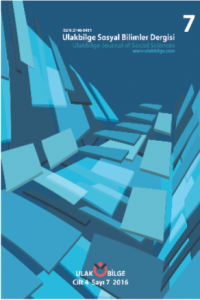Abstract
Güzellik tarih boyunca binlerce yıldır felsefecilerin tanımını bulmakta
zorlandıkları bir konu olagelmiştir. “Güzel”in ne olduğu konusunda Plato’dan beri
güzelliğin kişisel olabileceği veya kültürel olarak değişebileceği gibi pek çok farklı
teoriler ortaya atılmış olmasına karşın, bunların hiç biri bilimsel, nesnel temellere
dayanan teoriler olmamıştır. Charles Darwin (1809-1882)’in Evrim Teorisi, ölümünün
üzerinden çok uzun bir zaman geçmesine rağmen psikoloji, antropoloji, sosyoloji gibi
alanlarda pek çok yeni araştırma ve teoriye temel teşkil etmektedir. İnsanlığın
milyonlarca yıl kullandığı kesici el baltaları, sürpriz bir şekilde evrim teorisinden
dayanak alarak Denis Dutton* (1944-2010)’ın Evrimci Güzellik Teorisi’ne temel
teşkil etmiştir. Güzelliğin cevabının nesnel olabileceği ve evrimsel süreçte
genlerimize kodlanmış evrensel bir güzellik anlayışı olabileceği bilinen paradigmaları
alt üst edebilecek bir yaklaşım olup, estetik, sanat ve eğitimde yepyeni çıkarımlara
sebep olabilecektir.
References
- Barkow, J. H., Cosmides, L., ve Tooby, J. (eds.) (1992). The Adapted Mind: Evolutionary Psychology and the Generation of Culture. New York: Oxford University Press. Cronin, H. (1991). The Ant and the Peacock. Cambridge: Cambridge University Press. Danto, A. C. (1964). The Artworld. Journal of Philosophy, 61:571–84. Dutton, D. (2003). “Aesthetics and Evolutionary Psychology,” in J. Levinson (ed.), The Oxford Handbook for Aesthetics. New York: Oxford University Press. Dutton, D. (2009). The Art Instinct: Beauty, pleasure and human evolution. New York: Bloomsbury Press. Godlovitch, S. (1998). Musical Performance. London: Routledge. Hume, D. (1987). “Of the Standard of Taste,” in E. F. Miller (ed.), Essays, Moral, Political, Literary. Indianapolis: Bobbs-Merrill. Kant, I. (1987). The Critique of Judgment, trans. W. Pluhar. Indianapolis: Hackett. Komar, V. & Melamid, A. (1998). Komar and Melamid Discover Pleistocene Taste. Philosophy and Literature, 22: 486–96. Miller, G. F. (2000). The Mating Mind: How Sexual Choice Shaped the Evolution of Human Nature. New York: Doubleday. Mithen, S. (1996). The Prehistory of the Mind: A Search for the Origins of Art, Religion, and Science. London: Thames & Hudson. Orians, G. H. & Heerwagen, J. H. (1992). “Evolved Responses to Landscapes,” in J. Barkow et al. (eds.), The Adapted Mind. New York: Oxford University Press. Wypijewski, J. (Ed.) (1997). Painting by Numbers: Komar and Melamid’s Guide to Art. New York: Farrar, Straus & Giroux. Zahavi, Am. & Zahavi, Av. (1997). The Handicap Principle: A Missing Piece of Darwin’s Puzzle. New York: Oxford University Press.
Abstract
References
- Barkow, J. H., Cosmides, L., ve Tooby, J. (eds.) (1992). The Adapted Mind: Evolutionary Psychology and the Generation of Culture. New York: Oxford University Press. Cronin, H. (1991). The Ant and the Peacock. Cambridge: Cambridge University Press. Danto, A. C. (1964). The Artworld. Journal of Philosophy, 61:571–84. Dutton, D. (2003). “Aesthetics and Evolutionary Psychology,” in J. Levinson (ed.), The Oxford Handbook for Aesthetics. New York: Oxford University Press. Dutton, D. (2009). The Art Instinct: Beauty, pleasure and human evolution. New York: Bloomsbury Press. Godlovitch, S. (1998). Musical Performance. London: Routledge. Hume, D. (1987). “Of the Standard of Taste,” in E. F. Miller (ed.), Essays, Moral, Political, Literary. Indianapolis: Bobbs-Merrill. Kant, I. (1987). The Critique of Judgment, trans. W. Pluhar. Indianapolis: Hackett. Komar, V. & Melamid, A. (1998). Komar and Melamid Discover Pleistocene Taste. Philosophy and Literature, 22: 486–96. Miller, G. F. (2000). The Mating Mind: How Sexual Choice Shaped the Evolution of Human Nature. New York: Doubleday. Mithen, S. (1996). The Prehistory of the Mind: A Search for the Origins of Art, Religion, and Science. London: Thames & Hudson. Orians, G. H. & Heerwagen, J. H. (1992). “Evolved Responses to Landscapes,” in J. Barkow et al. (eds.), The Adapted Mind. New York: Oxford University Press. Wypijewski, J. (Ed.) (1997). Painting by Numbers: Komar and Melamid’s Guide to Art. New York: Farrar, Straus & Giroux. Zahavi, Am. & Zahavi, Av. (1997). The Handicap Principle: A Missing Piece of Darwin’s Puzzle. New York: Oxford University Press.
Details
| Primary Language | Turkish |
|---|---|
| Journal Section | Articles |
| Authors | |
| Publication Date | January 1, 2016 |
| Published in Issue | Year 2016 Volume: 4 Issue: 7 |


